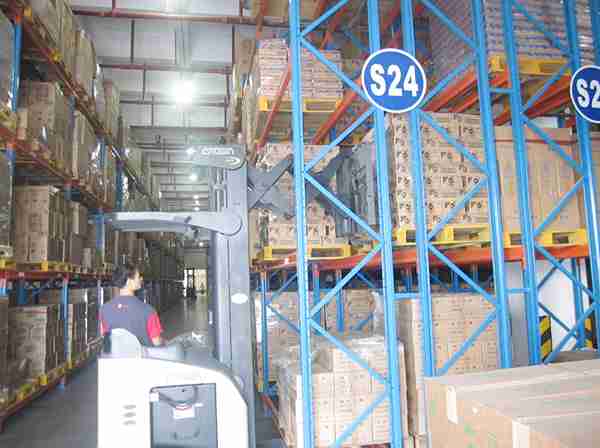📐 "First 50 Enterprise Queries Get Custom 3D Warehouse Design" Plan

Introduction
Double deep racks are a high-density storage solution that maximizes warehouse space by storing pallets two-deep. However, without proper post-installation double deep testing, these systems can become safety hazards, leading to collapses, forklift accidents, and regulatory violations.
This guide provides a step-by-step breakdown of post-installation double deep testing, ensuring compliance with OSHA, RMI, and EN standards while optimizing operational efficiency. Warehouse managers, safety inspectors, and logistics professionals will find actionable insights to verify structural integrity, prevent accidents, and extend rack lifespan.

1. Why Post-Installation Double Deep Testing is Critical
Double deep racks endure constant stress from forklifts, heavy loads, and dynamic warehouse operations. Skipping post-installation double deep testing can result in:
- Catastrophic rack failures due to undetected installation flaws
- Forklift collisions from misaligned beams or insufficient aisle space
- Regulatory fines for non-compliance with safety standards
- Premature wear, leading to costly repairs or replacements
By implementing a rigorous post-installation double deep testing protocol, warehouses ensure long-term safety, compliance, and peak performance.
2. Initial Visual Inspection: The Foundation of Post-Installation Double Deep Testing
Before conducting advanced tests, a detailed visual inspection is essential.
2.1. Upright Frame Alignment & Plumbness
- Use a laser level or plumb bob to confirm uprights are perfectly vertical.
- Even a 0.5° deviation can compromise stability under load.
2.2. Beam-to-Column Connection Integrity
- Verify all locking mechanisms (teardrop, boltless, or welded connections) are fully secured.
- Missing or loose bolts are a common post-installation issue that must be corrected.
2.3. Floor Anchoring & Load Distribution
- Inspect anchor bolts for proper torque (per manufacturer specifications).
- Apply lateral force—racks should not shift if anchored correctly.
3. Load Testing: Simulating Real-World Warehouse Demands
Post-installation double deep testing must include static and dynamic load assessments to confirm structural integrity.
3.1. Static Load Test (Assessing Weight Capacity)
- Load pallets to maximum rated capacity (following RMI/ANSI MH16.1 standards).
- Monitor for beam deflection or frame bending over 24-48 hours.
3.2. Dynamic Load Test (Forklift Impact Simulation)
- Have a forklift repeatedly insert and remove pallets at different heights.
- Excessive beam movement or sway indicates weak connections needing reinforcement.
4. Forklift Clearance & Operational Safety Checks
Since double deep racks require precise forklift maneuvering, post-installation double deep testing must verify:
4.1. Aisle Width Compliance
- Measure aisle width against OSHA & manufacturer guidelines.
- Ensure minimum clearance (12-18 inches) between pallets and uprights.
4.2. Forklift Entry & Exit Angles
- Test 90° and 45° approaches—racks must allow smooth pallet retrieval.
- Adjust if forklifts scrape beams or struggle with deep positioning.
5. Seismic & Environmental Stress Testing (For High-Risk Warehouses)
In earthquake-prone or high-wind regions, post-installation double deep testing must include:
5.1. Lateral Force Resistance Test
- Apply horizontal pressure (via hydraulic jack) to simulate seismic forces.
- Racks must resist deformation within FEMA/EN 1998-1 tolerances.
5.2. Vibration & Harmonic Stability Test
- Use vibration sensors to detect resonance frequencies that weaken joints over time.
6. Compliance Documentation & Final Certification
After completing post-installation double deep testing, warehouses must:
- Document all test results (photos, measurements, load data).
- Obtain engineer certification (if required by local regulations).
- Maintain records for OSHA/RMI compliance audits.
Conclusion
Post-installation double deep testing is not optional—it’s a critical safety and efficiency requirement. By following this guide, warehouses ensure their double deep racking systems are structurally sound, compliant, and optimized for long-term use.
For ongoing safety, bi-annual inspections are recommended. Consult the Rack Manufacturers Institute (RMI) or a professional structural engineer for further guidance.
FAQs
1. How often should post-installation double deep testing be performed?
Initial testing must occur immediately after installation, followed by bi-annual inspections unless damage is suspected.
2. Can wooden beams be used in double deep racks?
No—steel beams are mandatory for load-bearing integrity. Wood cannot support heavy palletized loads safely.
3. What’s the maximum allowable beam deflection in double deep racks?
Per ANSI MH16.1, deflection should not exceed L/180 (where L = beam length).
4. Is an engineer’s certification required for post-installation double deep testing?
In high-risk regions (seismic zones, heavy industrial use), an engineer’s stamp is often mandatory.
5. How do I verify if my warehouse floor can support double deep racks?
Conduct a floor load capacity test—most warehouses require ≥ 2,500 PSI concrete.




